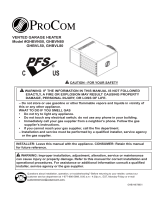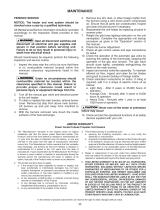
17
6-583.8
INSTALLATION - OPERATION
OPERATION
Prior to Operation
Although this unit has been assembled and fire-tested at the
factory, the following pre-operational procedures should be
performed to assure proper on-site operation.
1. Turn off power to the unit at the disconnect switch. Check
that fuses or circuit breakers are in place and sized correctly.
Turn all hand gas valves to the “OFF” position.
2. Remove the side control access panel.
3. Check that the supply voltage matches the unit supply
voltage listed on the Model Identification plate. Verify that
all wiring is secure and properly protected. Trace circuits to
insure that the unit has been wired according to the wiring
diagram. If installed at altitudes above 2,000' and the high
altitude kit includes a combustion air proving switch, replace
the switch in the unit with the switch provided in the kit. Take
care to ensure that the tubing and electrical connections are
securely fastened.
4. Check to insure that the venting system is installed correctly
and free from obstructions. Before you start use the following
steps to verify that the venting system is adequately sized:
a. Seal any unused openings in the venting system.
b. Inspect the venting system for proper size and horizontal
pitch, as required in the National Fuel Gas Code, ANSI
Z223.1 (NFPA 54) or CSA B149.1 Installation Code - latest
edition and these instructions. Determine that there is
no blockage or restriction, leakage, corrosion and other
deficiencies, which could cause an unsafe condition.
c. Insofar as practical, close all building doors and windows
and all doors between the space in which the appliance(s)
connected to the venting system are located and other
spaces of the building. Turn on clothes dryers and any
exhaust fans such as range hoods and bathroom exhausts,
so they shall operate at maximum speed. Do not operate a
summer exhaust fan. Close fireplace dampers.
d. Follow the lighting instructions. Place the appliance being
inspected in operation. Adjust thermostat so that the
appliance will operate continuously.
e. After it has been determined that each appliance connected
to the venting system properly vents when tested as
outlined above, return doors, windows, exhaust fans,
fireplace dampers and any other gas-burning appliance to
their previous conditions of use.
f. If improper venting is observed during any of the above
tests, the venting system must be corrected.
5. Check to see that there are no obstructions to the intake and
discharge of the unit.
6.
Check fan clearance. Fan should not contact casing when
spun by hand.
7. Check to make sure that all filters are in place and that
they are installed properly according to direction of air flow
(if applicable).
8. Perform a visual inspection of the unit to make sure no
damage has occurred during installation. Check to ensure all
fasteners are in place and the burner openings are properly
aligned with the heat exchanger tubes and that the gas orifices
are centered in the burner inspirator tube opening.
9. Check that all horizontal deflector blades are open a minimum
of 30° as measured from vertical.
10. Turn on power to the unit at the disconnect switch.
11. Check the thermostat, ignition control, gas valve, and supply
fan blower motor for electrical operation. If these do not
function, check that the wiring is per the diagram.
12. Check the blower wheel for proper direction of rotation when
compared to the air flow direction arrow on the blower
housing (if applicable). Blower wheel rotation, not air
movement, must be checked as some air will be delivered
through the unit with the blower wheel running backwards.
13. For blower units, check the blower speed (RPM). Refer to
“Blower Adjustments” for modification.
14. Check the motor speed (RPM).
15. Check the motor voltage.
16. Check the motor amp draw to make sure it does not exceed
the motor nameplate rating.
17. Recheck the gas supply pressure at the field installed
manual shut-off valve. The minimum inlet pressure should
be 6" W.C. on natural gas and 11" W.C. on propane gas.
The maximum inlet pressure for either gas is 14" W.C. If
inlet pressure exceeds 14" W.C., a gas pressure regulator
must be added upstream of the combination gas valve.
18. Open the field installed manual gas shut-off valve.
19. Place the manual main gas valve on the combination gas
valve in the “ON” position. Call for heat with the thermostat.
20. Check to make sure that the main gas valve opens. Check
the manifold gas pressure (See “Main Burner Adjustment”)
while the supply fan blower is operating.
21. Check to insure that gas controls sequence properly (see
“Control Operating Sequence”). If you are not familiar with
theunit’scontrols(i.e.combinationgascontrol),refertothe
controlmanufacturer’sliteraturesuppliedwiththeunit.
22. Once proper operation of the unit has been verified,
remove any jumper wires that were required for testing.
24. Replace the side control access panel.
25. If installed at altitudes above 2,000', affix label included with
high altitude kit and fill in all fields with a permanent marker.
Main Burner Adjustment
The gas pressure regulator (integral to the combination gas
control) is adjusted at the factory for average gas conditions. It is
important that gas be supplied to the unit heater in accordance
with the input rating on the serial plate. Actual input should be
checked and necessary adjustments made after the unit heater is
installed. Over-firing, a result of too high an input, reduces the
life of the appliance and increases maintenance. Under no
circumstances should the input exceed that shown on the serial
plate.Measuring the manifold pressure is done at the outlet
pressure tap of the gas valve.
To Adjust the Manifold Pressure
1. Move the field installed manual shut-off valve to the “OFF”
position.
2. Remove the 1/8
"
pipe plug from the outlet pressure tap on
the gas valve and attach a water manometer of “U” tube type
which is at least 12
"
high.
3. Move the field installed manual gas shut-off valve to the “ON”
position.
4. Create a high-fire call for heat from the thermostat.
5. Refer to Table 12.1 to determine the correct high fire manifold
pressure for the gas type of the unit. Pressures at 0-2,000'
elevation are 3.5" W.C. for natural gas, 10" W.C. for propane
gas, for elevations above 2,000' refer to the instructions on
page 13. Adjust the main gas pressure regulator spring to
achieve the proper manifold pressure (for location, see the
combination gas control literature supplied with unit).
6. After adjustment, move the field installed manual shut-off valve
to the “OFF” position and replace the 1/8
"
pipe plug.
7. After the plug is in place, move the field installed manual shut-
off valve to the “ON” position and recheck pipe plugs for gas
leaks with soap solution.
IMPORTANT
1. To prevent premature heat exchanger failure, observe
heat exchanger tubes. If the bottom of the tubes become
red while blower and furnace are in operation, check to be
sure the blower has been set to the proper RPM for the
application. Refer to page 16 for wiring adjustments for
blower motors.
2. Start-up and adjustment procedures must be performed
by a qualified service agency.





















